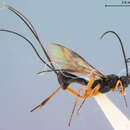Distribution
provided by Catalog of Hymenoptera in America North of Mexico
Alta., Oreg.
- bibliographic citation
- Catalog of Hymenoptera in America North of Mexico. 1979. Prepared cooperatively by specialists on the various groups of Hymenoptera under the direction of Karl V. Krombein and Paul D. Hurd, Jr., Smithsonian Institution, and David R. Smith and B. D. Burks, Systematic Entomology Laboratory, Insect Identification and Beneficial Insect Introduction Institute. Science and Education Administration, United States Department of Agriculture.
Comprehensive Description
provided by Smithsonian Contributions to Zoology
Orgilus agrestis
This species differs from related forms especially in having the first four tergites closely sculptured and the following largely retracted.
FEMALE.—Length about 4 mm. Head slightly broader than thorax, in dorsal view two-thirds as long as wide; face about 1.4 times as broad as eye height, punctate below, finely rugulose medially above, shagreened laterally; clypeus shiny, punctate; malar space distinctly more than half as long as eye height, minutely granulose and dull; cheeks sculptured like malar space; temples receding gradually from eye margins and at mideye point about as wide as eyes, granulose or shagreened behind, smooth and shiny along eye margins; occipital carina narrowly interrupted medially; frons smooth medially, granulose and mat laterally; ocellocular line more than twice as long as diameter of an ocellus; antennae 33- or 34-segmented in the available specimens, even the shortest segments in apical fourth of flagellum a little longer than broad.
Mesoscutum with some very shallow punctures, which are most noticeable on the middle lobe; notauli foveolate, meeting in a small rugulose area; propodeum gently convex, finely rugulose but with a small smooth and polished area each side at base, the stubs of the longitudinal carinae that arise from the posterior margin not distinct; side of pronotum largely rugulose punctate; mesopleuron smooth and polished, with the longitudinal furrow foveolate; metapleuron rugulose posteriorly, irregularly punctate anteriorly. Hind coxa barely more than half as long as hind femur and largely finely rugulose; hind femur about five times as long as broad; longer calcarium of hind tibia just about half as long as metatarsus; tarsal claws simple. Radial cell on wing margin hardly as long as stigma; second abscissa of radius on a line with intercubitus; stub of third abscissa of cubitus as long as the second abscissa; nervulus a little postfurcal; hind wing a little less than five times as long as wide; lower abscissa of basella longer than nervellus but not half as long as mediella or maximum width of hind wing.
Abdomen as wide as thorax; first tergite about 1.2 times as long as wide at apex, finely rugulose punctate, the dorsal keels not developed; second tergite a little broader at base than long, the third strongly transverse, and both closely confluently punctate or very finely rugulose punctate, the third smooth and polished along its posterior margin; fourth tergite largely confluently punctate but more weakly so than second and third, smooth apically; the following almost completely retracted, only a little of the fifth tergite being visible; second suture sharply impressed and relatively broad; ovipositor sheath barely as long as abdomen.
Head and thorax black; clypeus largely and mandibles red; antennae light brown, blackish apically; palpi dark; tegulae black, wing bases brownish yellow; wings hyaline at bases, noticeably smoky on apical two-thirds; legs yellowish brown, the hind coxae basally, the trochanters in part, all femora inwardly more or less, hind tibiae and all tarsi, somewhat darkened; abdomen reddish brown to black, always black apically.
MALE.—Unknown.
HOLOTYPE.—USNM 70139.
DISTRIBUTION.—Known only from the holotype female collected 12 miles southeast of Bend, Oregon, on Artemisia tridentata, 19 July 1957, by Gerald F. Craft, and a female paratype taken by W. R. M. Mason at Drumheller, Alberta, 14 June 1946.
- bibliographic citation
- Muesebeck, Carl F. W. 1970. "The Nearctic species of Orgilus Haliday (Hymenoptera: Braconidae)." Smithsonian Contributions to Zoology. 1-104. https://doi.org/10.5479/si.00810282.30

